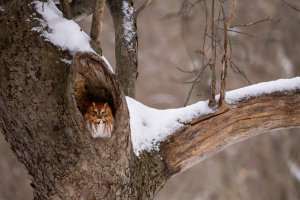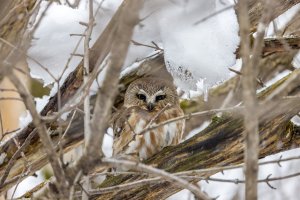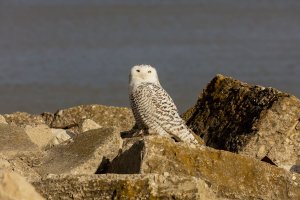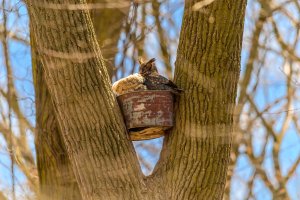Owls in Winter
December 13, 2023
Paul Cypher, Park Interpreter
Winter is on its way. Whether we have feet of snow or mild temps with slop, we need to be prepared. What’s on your list of things to do? Get the snowblower ready just in case? Check. Mothball the lawn mower? Easy. Start planning meals for the Holiday Season? Fair enough. Start thinking about owls?
Huh?
Let’s face it – if you’re like me, you don’t care about the first two. And we all love good food, right? But owls?
Now we’re talking…
The first thing to consider is that they are simply not as rare as many folks may think. Three species breed in southeast Michigan – Great Horned Owl, Eastern Screech Owl, and Barred Owl. Further, they don’t migrate, so they are here throughout the year.
If you have the room to do it and the right yard for it, consider a screech owl box on your property. But you had better do it soon. Mom and Dad owl are not yet a couple. Each will have their own space until the breeding season starts in March. The female will ultimately pick the best location. So, if you are like me, you will have a male owl in your box all winter long only to have him leave and spend the spring with her in her nest cavity. But that’s okay. Seeing his little face at sunset peering from the hole is plenty rewarding. I’m content to know he is helping raise a family somewhere nearby.

Barred Owl and Great Horned Owl? Well, there is not much you can do to “attract them” to your yard. They do what they do. Barred look for huge cavities in large tracts of wet woods while the Great Horneds use whatever they can – broken treetops, cavities, and even old nests from Red-tailed Hawks.
But for many, it is the “winter owls” that really start to get people excited. Long-eared Owls (the size of a two-liter bottle) and Northern Saw-whet Owls (the size of pop-cans) begin to arrive in southeast Michigan beginning around Halloween. They will stay in the region well into spring. But finding them is the trick.

First, don’t look for them at night. They’re off hunting and you are basically wasting your time. Look for them during the daylight hours when they are on the roost. For both species, they prefer “tight quarters” –pine trees (especially cedars), grapevine tangles, or scraggly trees like hawthorns.
Also be sure to look on the ground for their droppings. Yes, that’s right – you don’t always look for the owl – you look for their poop. Officially called “whitewash”, the chalky/drippy excrement is a tell-tale sign of an owl. The longer they use the roost, the more whitewash you will find on the ground under it.
In the end, its really simple. Investigate your property every day. Are you checking the mail? Check the grapevines along the fence! Bringing in groceries from the car? Check the pine tree in the front yard. Seriously. Do it. I do. It only takes a moment.
We can’t overlook the Snowy Owl. This majestic white bird from the tundra (every bit the size of a Red-tailed Hawk) shows up where it wants when it wants between Thanksgiving and early spring. They are perfectly comfortable just about anywhere – farm fields, suburban or even urban environments. They’ll sit on cars, buildings, telephone poles, streetlights, the ground, and just about any other place you can imagine. Don’t worry – you may find dozens of white grocery store bags hooked on fences before you see your first, but it happens to all of us!

Let’s say you find an owl in your yard or a park nearby? Now what?
It’s simple. If it is a “long eared” or “saw-whet”, crouch, back up slowly, and enjoy from a reasonable distance. (Remember, you probably are quite close to them when you found them on the roost.) If the bird shows signs of distress like standing tall or opening its eyes wide, you are way too close. If you are a photographer, don’t use a flash. Further, don’t even think about trimming branches to get the “perfect” shot. They chose that spot for a reason. Altering it in anyway is potentially troublesome. Owls on the roost are resting up for their nocturnal hunts, digesting their evening meals, and just managing their metabolisms in the cold conditions. People waking them to get “the perfect shot” can cause real harm through unnecessary energy expenditures and even causing the owl(s) to flush from their safe and purposefully-chosen roost.
For “Snowies”, just keep your distance and enjoy them with binoculars!
For the record, the winter of ’23-’24 is shaping up to be an interesting one. Ornithologists (people who study birds) are waiting patiently to find out if the horrible forest fires in Canada during the summer will have an impact on owls this winter.
You can help.
Learn your owls. Check your yard. Use good etiquette. Confirm your sightings with Metropark Interpreters, if needed. Enter your records at eBird.com (its free!). Contribute to our knowledge of birds. Enjoy observing owls during owl programs, from the trails at Lake St Clair Metropark where Great Horned Owls routinely nest in a “bucket” visible from the trail, and make sure your enthusiasm doesn’t get in the way of a safe experience for the owls, too!

And don’t forget to winterize that mower….
